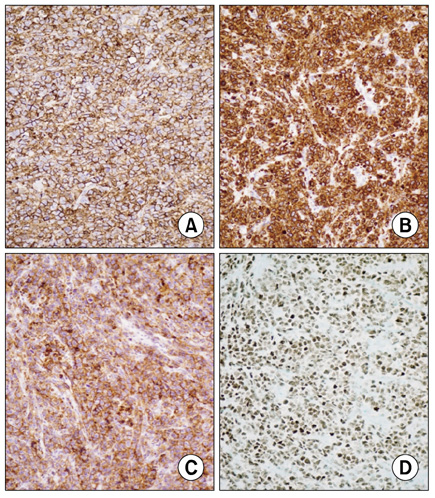J Korean Surg Soc.
2012 Jan;82(1):50-53. 10.4174/jkss.2012.82.1.50.
Post-transplant lymphoproliferative disorder presented as small bowel intussusception in adult liver transplant patient
- Affiliations
-
- 1Department of Surgery, University of Miami School of Medicine, Miami, FL, USA. JMoon@med.miami.edu
- 2Department of Surgery, Kyung Hee University School of Medicine, Seoul, Korea.
- 3Department of Medicine, University of Miami School of Medicine, Miami, FL, USA.
- 4Department of Pathology, University of Miami School of Medicine, Miami, FL, USA.
- KMID: 1437759
- DOI: http://doi.org/10.4174/jkss.2012.82.1.50
Abstract
- Intestinal obstruction after liver transplant is a rare complication, with diverse clinical manifestations. Intestinal adhesion is the most common cause. However, internal hernia, abdominal wall hernia, and neoplasm are also reported. Intussusception is another rare cause of intestinal obstruction, which has been reported primarily in pediatric patients. Herein, we report a case of intestinal obstruction from intussusception in an adult liver transplant patient associated with post-transplant lymphoproliferative disorder.
MeSH Terms
Figure
Reference
-
1. Menzies D, Ellis H. Intestinal obstruction from adhesions--how big is the problem? Ann R Coll Surg Engl. 1990. 72:60–63.2. Blachar A, Federle MP. Bowel obstruction following liver transplantation: clinical and ct findings in 48 cases with emphasis on internal hernia. Radiology. 2001. 218:384–388.3. Nishida S, Pinna AG, Nery JR, Levi D, Kato T, Madariaga J, et al. Internal hernia of the small bowel around infrarenal arterial conduits after liver transplantation. Clin Transplant. 2002. 16:334–338.4. Earl TM, Wellen JR, Anderson CD, Nadler M, Doyle MM, Shenoy SS, et al. Small bowel obstruction after pediatric liver transplantation: the unusual is the usual. J Am Coll Surg. 2011. 212:62–67.5. Shin N, Hasegawa K, Ikeda M, Ishizawa T, Kokudo N, Sugawara Y, et al. Adult intussusception induced by the stump of the jejunal loop after liver transplantation. Hepatogastroenterology. 2008. 55:898–899.6. Azar T, Berger DL. Adult intussusception. Ann Surg. 1997. 226:134–138.7. Barshes NR, Lee TC, Karpen SJ, Bristow LJ, Quiros-Tejeira RE, Goss JA. Asymptomatic small bowel intussusception associated with post-transplant lymphoproliferative disease. Pediatr Transplant. 2004. 8:196–197.8. Burns DM, Crawford DH. Epstein-Barr virus-specific cytotoxic T-lymphocytes for adoptive immunotherapy of posttransplant lymphoproliferative disease. Blood Rev. 2004. 18:193–209.9. Penn I. The role of immunosuppression in lymphoma formation. Springer Semin Immunopathol. 1998. 20:343–355.10. Cesarman E, Chadburn A, Liu YF, Migliazza A, Dalla-Favera R, Knowles DM. BCL-6 gene mutations in posttransplantation lymphoproliferative disorders predict response to therapy and clinical outcome. Blood. 1998. 92:2294–2302.
- Full Text Links
- Actions
-
Cited
- CITED
-
- Close
- Share
- Similar articles
-
- Cerebral Post-Transplant Lymphoproliferative Disorder Occurring after Renal Transplantation: A Case Report
- Posttransplant Lymphoproliferative Disorder without Epstein-Barr Virus Presented as Small Bowel Perforation in Renal Transplant Recipient: A Case Report
- Pediatric Liver Transplantation
- Successful treatment of the Epstein-Barr virus-negative post-transplant lymphoproliferative disorder, Ann Anbor stage IVB, using R-CHOP: a case report
- Post-transplantation Lymphoproliferative Disorder in Transplanted Liver: A Case Report





